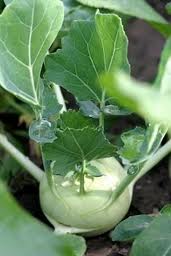Kohlrabi at your yard
http://manwha21.blog.me/130044904565 (See 'How to Grow')


Kohlrabi
 Kohlrabi is a part of the cabbage family. It was first grown in Europe around 1500 and was imported into America 300 years later. It has a turnip like appearance, with leaves standing out like spokes from the edible portion, which is a rounded, enlarged stem section growing just above the soil line. Kohlrabi is sometimes misclassified as a root vegetable.
Kohlrabi is a part of the cabbage family. It was first grown in Europe around 1500 and was imported into America 300 years later. It has a turnip like appearance, with leaves standing out like spokes from the edible portion, which is a rounded, enlarged stem section growing just above the soil line. Kohlrabi is sometimes misclassified as a root vegetable.
Recommended Varieties
White (really light green)
Early White Vienna (55 days to harvest)
Express Forcer (42 days)
Grand Duke (hybrid-50 days)
Kolpak (hybrid-38 days)
Triumph (55 days)
Purple
Blaro (43 days)
Early Purple Vienna (62 days)
Rapid (45 days)
When to Plant
Sow seeds in early spring. Make small plantings every 2 to 3 weeks for continuous spring and early summer harvest. For an especially early harvest, plants may be started indoors or in the greenhouse in flats to be transplanted into the garden as soon as the ground becomes workable. Like cabbage, kohlrabi plants can stand some frost. One or two late plantings can also be made in mid-summer at the same time as late cabbage. In very hot weather, these seedlings may benefit from some shade when they are small.
Spacing & Depth
Sow seeds in rows and cover them 1/4 to 1/2 inch deep. Thin the seedlings to 2 to 5 inches apart. Transplant the surplus seedlings to fill in blanks in other parts of the row or into additional row space if more harvest is desired. Discard excess plants or use them for tender, stir-fry greens.
Care
Plant in fertile soil, maintain adequate soil moisture and keep down weeds. Proper care allows kohlrabi to achieve the rapid growth that results in the best quality.
Harvesting
Kohlrabi has the mildest and best flavor (resembling mild white turnips) when small. Unfortunately, many gardeners allow kohlrabi to grow too large before harvesting it. Large, older kohlrabi is tough and woody and it may have an off-flavor. Begin harvesting (pull or cut at ground level) when the first stems are about one inch in diameter. Continue harvest until the stems are 2 to 3 inches in diameter. When the stems get much bigger than 3 inches, they begin to develop woody fibers, especially in the lower part of the expanded stem. Even overgrown kohlrabi still may have some tender and tasty tissue at the top, where the youngest leaves continue to emerge as the plant grow. The young leaves may be cooked like other greens.